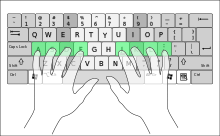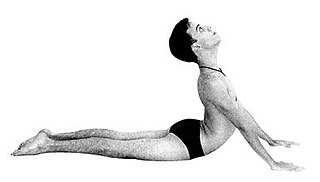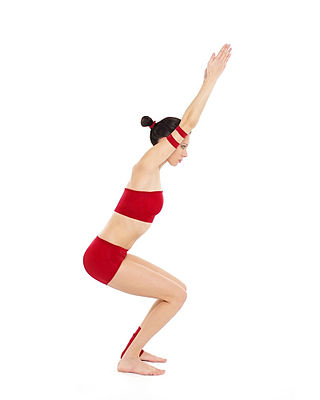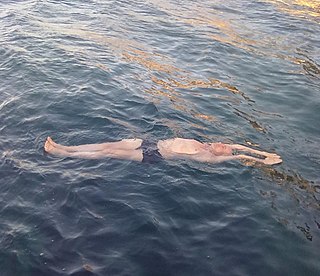
A resting position or rest position is a default human position or pose assumed (typically deliberately) when a person is not engaged in an activity that demands some other pose, or between poses.

A resting position or rest position is a default human position or pose assumed (typically deliberately) when a person is not engaged in an activity that demands some other pose, or between poses.
Common resting positions of the body include kneeling, leaning, lying, sitting, and squatting. In microgravity, the relaxed human body naturally assumes neutral body posture. [1]



A number of disciplines specify particular resting positions, with various purposes.
Ballet incorporates several resting poses, including a neutral pose described by Cesare Negri and Jacob de Gheyn II with the feet at 45 degrees, back strait, and chin erect. [2] Neoclassical ballet includes a rest or "preparatory" position called "B plus" (possibly named for George Balanchine), also called attitude a terre, in which the standing leg is straight, and the back leg curved with the toe pointed. [3]
Military parade discipline includes standing rest positions, generally assumed following a command of "At ease", "Stand easy", or "Relax". [4] [5]
Some forms of yoga incorporate the Shavasana or "Corpse Pose", a rest position used for wakeful relaxation and meditation, often at the end of a session. [6]
Gun safety rules generally specify that the trigger finger should not rest on the trigger when not firing, but alongside the trigger guard. [7]
In various sign languages, rest positions may be used to convey grammatical meaning. [8]
In touch typing, the home row is a rest position for the hands, placing all the standard keys within easy reach. [9]

Lotus position or Padmasana is a cross-legged sitting meditation pose from ancient India, in which each foot is placed on the opposite thigh. It is an ancient asana in yoga, predating hatha yoga, and is widely used for meditation in Hindu, Tantra, Jain, and Buddhist traditions.

Drill commands are generally used with a group that is marching, most often in military foot drills or in a marching band. Drill commands are usually heard in major events involving service personnel, reservists and veterans of a country's armed forces, and by extension, public security services and youth uniformed organizations.

A handstand is the act of supporting the body in a stable, inverted vertical position by balancing on the hands. In a basic handstand, the body is held straight with arms and legs fully extended, with hands spaced approximately shoulder-width apart and the legs together. There are many variations of handstands, all of which require the performer to possess adequate balance and upper body strength.

Bhujangasana or Cobra Pose is a reclining back-bending asana in hatha yoga and modern yoga as exercise. It is commonly performed in a cycle of asanas in Surya Namaskar, Salute to the Sun, as an alternative to Urdhva Mukha Svanasana, Upward Dog Pose. The Yin Yoga form is Sphinx Pose.

Viparita Dandasana or Inverted Staff Pose is an inverted back-bending asana in modern yoga as exercise. It may be performed with both feet on the ground, or with one leg raised straight up.

Bālāsana or Child Pose, is a kneeling asana in modern yoga as exercise. Balasana is a counter asana for various asanas and is usually practiced before and after Sirsasana.

Trikonasana or Utthita Trikonasana, [Extended] Triangle Pose is a standing asana in modern yoga as exercise. Variations include Baddha Trikonasana and Parivrtta Trikonasana.
Tadasana, Mountain pose or Samasthiti is a standing asana in modern yoga as exercise; it is not described in medieval hatha yoga texts. It is the basis for several other standing asanas.

Shavasana, Corpse Pose, or Mritasana, is an asana in hatha yoga and modern yoga as exercise, often used for relaxation at the end of a session. It is the usual pose for the practice of yoga nidra meditation, and is an important pose in Restorative Yoga.

Tree pose or Vrikshasana is a balancing asana. It is one of the very few standing poses in medieval hatha yoga, and remains popular in modern yoga as exercise. The pose has been called iconic of modern yoga; it is often featured in yoga magazines, and practised in public displays such as for the International Day of Yoga.

Utkatasana, Chair Pose, or fierce pose, is a standing asana in modern yoga as exercise. It was a low squatting asana in medieval hatha yoga.

Meditative postures or meditation seats are the body positions or asanas, usually sitting but also sometimes standing or reclining, used to facilitate meditation. Best known in the Buddhist and Hindu traditions are the lotus and kneeling positions; other options include sitting on a chair, with the spine upright.

Core Strength Vinyasa Yoga is a style of yoga as exercise created by American yogini Sadie Nardini in 2006. Central to this style is a movement referred to as a 'wave' (softening). The structure of this practice includes a 7-step framework which is applied to each pose within a sequence. Nardini incorporates aspects of Kundalini Yoga, Sivananda Yoga, Anusara Yoga, Iyengar Yoga, and portions of movement sequences from Ashtanga Vinyasa Yoga. Maintaining an internal focus on joy in the moment is part of the practice philosophy. This style integrates postures with learnings from many disciplines including physics, biology, and geometry, influenced by the works of Leslie Kaminoff. It incorporates traditional yoga philosophy from the Yoga Sutras of Patanjali. It emphasizes muscles that are deep within the body and includes the use of 'waves' in order to enter and exit poses. Examples include physical moves that activate muscles close to the spine—such as psoas and quadratus lumborum in order to build support for the body from within before generating outward expression of that movement. The purpose of deep core focused poses in this practice is to improve and deepen breathing. This perspective differs from other styles in which the purpose of deep core work is to stabilize the back. In this practice, keeping belly soft and core strong improve breathing. "Belly Bonfire" breath is one example of a deep core breath technique that involves focus and target of attention and breath with softer abs. Pelvis is viewed as the body's physical center of gravity in this system.

Tittibhasana or Firefly pose is an arm-balancing asana with the legs stretched out forwards in hatha yoga and modern yoga as exercise. Variants include Bhujapidasana, with the legs crossed at the ankle, and Eka Hasta Bhujasana, with one leg stretched out forwards.

Vrischikasana or Scorpion pose is an inverted asana in modern yoga as exercise that combines a forearm balance and backbend; the variant with hands rather than forearms on the floor, elbows bent, is called Ganda Bherundasana. Light on Yoga treats both forearm and hand balance forms as variants of this pose. It is a part of the headstand cycle in some yoga traditions.

Utthita Hasta Padangusthasana, Standing Big Toe Hold or Extended Hand-to-Big-Toe Pose is a standing balancing asana in modern yoga as exercise.

Durvasasana or Durvasana, is an advanced standing asana in hatha yoga, with one leg raised and the foot hooked behind the neck. The similar Trivikramasana has the raised leg straight. There are seated and reclining variations including Bhairavasana. Versions of the pose are depicted in statues in Karnataka and Tamil Nadu from the 8th century onwards. Trivikramasana is described in the 18th century Haṭhābhyāsapaddhati; a pose close to Durvasasana is illustrated as "Trivikramasana" in the 19th century Sritattvanidhi.

Props used in yoga include chairs, blocks, belts, mats, blankets, bolsters, and straps. They are used in postural yoga to assist with correct alignment in an asana, for ease in mindful yoga practice, to enable poses to be held for longer periods in Yin Yoga, where support may allow muscles to relax, and to enable people with movement restricted for any reason, such as stiffness, injury, or arthritis, to continue with their practice.

Yashtikasana (Yastikasana) or Stick position is a beginner level yoga pose that is usually performed in preparation for more intermediate to advanced level asanas. In Sanskrit, "Yastik" means stick.
{{cite book}}: CS1 maint: location (link)